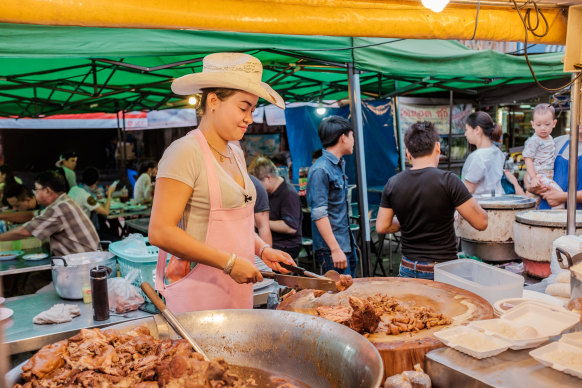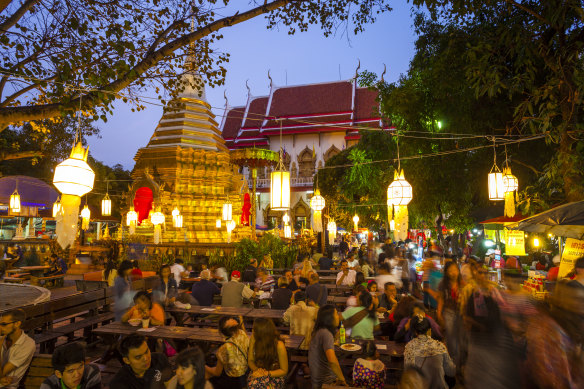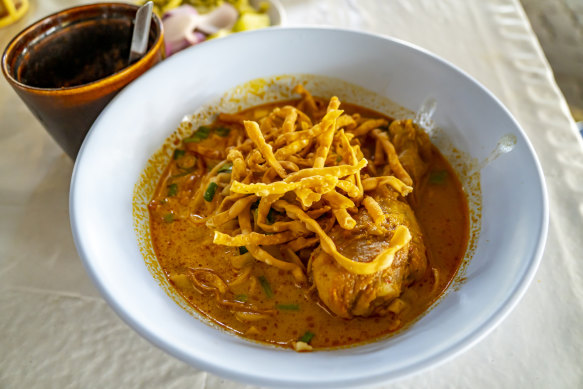Made famous by Anthony Bourdain, tourists still flock to ‘Cowboy Hat Lady’
“These people become popular, I don’t know why,” says my guide, Kiki, with a shrug. “Some foreign person selects them and puts them on TV and then they’re famous.
“But so many stalls here make food that is just as good.”

Chiang Mai’s “Cowboy Hat Lady” and her stall Khao Kha Moo Chang Phueak was made famous by Bourdain.Credit: Alamy
We’ve been talking about “Cowboy Hat Lady”, a woman famous around Chiang Mai, and now also around the world, for her street-food stall called Khao Kha Moo Chang Phueak. There, she sells just one dish: khao kha moo, slow-braised pork served over rice, with pickled mustard greens and an egg. And she serves it to the masses while wearing a cowboy hat.
The “foreign person” who made her so famous, meanwhile, is none other than Anthony Bourdain, the late TV presenter who visited this northern Thai capital in 2014 and called past Khao Kha Moo Chang Phueak for a plate of pork and rice. As a purveyor of good food, you don’t need much more to secure a lifetime of popularity.
And so, tourists in Chiang Mai these days – tourists like me – want to visit Cowboy Hat Lady, who still sports her signature headwear, and still dishes out her signature khao kha moo. We want to taste the food made famous by Anthony Bourdain.
And my guide, Kiki – full name Supachaya Sukkasem – a Chiang Mai local, still finds it all a bit weird, still thinks there are so many places around the city that are just as good if not better, and can’t understand why there aren’t hordes of tourists in front of those stalls, too.
It’s a fair question. Part of the answer, no doubt, is that many of us don’t know a huge amount about the cuisine of Chiang Mai, or indeed of northern Thailand in general. Most Thai food that is famous in Australia – coconut-based curries, stir-fried noodles, curry puffs, fish cakes – is the food of Bangkok and the Thai south.

Crowds congregate on market night where many food stalls are set up within the temple courtyard.Credit: iStock
We don’t have anywhere near the same level of exposure to the Lanna cuisine of the north, which takes influence from China and Myanmar to form something entirely different and also incredibly tasty.
My mission in Chiang Mai is to correct that imbalance. At least on a personal level. I’ve already eaten at Khao Kha Moo Chang Phueak, the stall positioned at a street-food market on the northern edge of Chiang Mai’s old town, and it was sheer gustatory delight: the pork incredibly tender, the master stock it’s served with full of Chinese five spice, the extra chilli sauce sitting on my rough metal table providing the perfect counterpoint to the meat’s sweetness.
And now I want more. With Kiki I’m heading to Han Teung Chiangmai, a casual restaurant on the outskirts of the city that apparently has also become famous – though, this time on Instagram among young Thai foodies, with no foreign celebrities involved.
The restaurant is a modest affair, an open-air space next to a dusty carpark, a few A-shaped roofs holding off seasonal rain. The menu, meanwhile, is a crash course in Lanna goodness, with everything from noodle soups to ant-egg specialties to curries to frog dishes to sun-dried meats.

Khao Soi: Chiang Mai’s famous noodle dish combines spicy and sour, salty and sweet.Credit: iStock
If there’s one dish Chiang Mai is best known for (at least around the rest of Thailand) it’s khao soi, a bowl of egg noodles in a rich, curry-based broth, topped with crunchy fried noodles, pickled mustard greens and hunks of meat. Han Teung Chiangmai isn’t a khao soi specialist, but it does do an excellent version, spicy and sour, salty and sweet.
I also have the chance here to try gaeng hung lay, a northern-Thai favourite, a ginger-heavy curry of pork meat and spices, plus a few more classics: sai oua, sausages packed with lemongrass and galangal; and nam prik num, a sambal of roasted green chillies with garlic and shallots.
Everything is served with sticky rice, yet another northern Thai obsession, big clumps of fragrant, delicious rice that you will rarely encounter in the south of the country.
It isn’t all classic or unique up here, however. Coffee is a city-wide passion in Chiang Mai, where there are far more cafes than temples. Fine-dining cuisine is popular, as evinced by the crowd of locals at Mai Restaurant, the modern Thai eatery at my hotel, the Melia Chiang Mai. There’s also a citywide fascination with shabu shabu, the Japanese specialty.
Some of this food and its purveyors have become famous; most still fly under the radar. But it’s all good.
DETAILS
Eat
Khao Kha Moo Chang Phueak is located at the Chang Phueak Gate night market, open daily from 5pm. Han Teung Chiangmai is on Soi Suthep, in the Suthep district, open daily from 9am.
Stay
The Melia Chiang Mai is a new, five-star hotel in central Chiang Mai. From $140 a night. See melia.com
Fly
Jetstar flies from Sydney to Phuket, and Melbourne to Bangkok, with onward connections to Chiang Mai. See jetstar.com
More
The writer travelled with assistance from the Melia Chiang Mai.
Sign up for the Traveller Deals newsletter
Get exclusive travel deals delivered straight to your inbox. Sign up now.